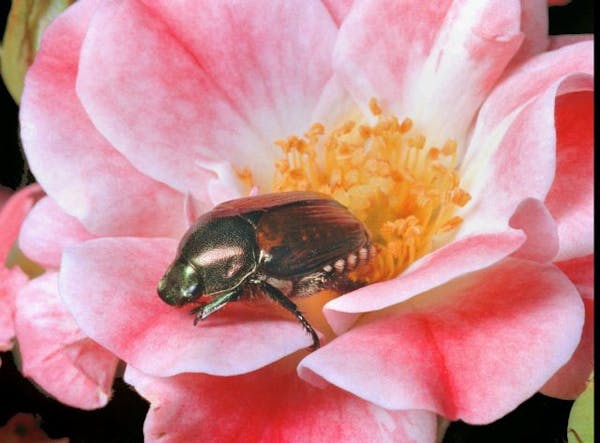Aditya Prabhu loved eating the peaches off the tree in the backyard of his mom's house.
The only problem was the plant produced only a few fruits a year because Japanese beetles in the hundreds would eat at the leaves, depleting the plant's energy to make peaches.
"The tree would be completely covered by the Japanese beetles because of their preference of fruit trees and orchards," the University of Minnesota computer engineering student said. "The whole point of growing them in the backyard was so we could do it organically, but we'd only have one to two peaches because the trees were so exhausted."
Prabhu's mother didn't want to spray the tree with pesticides. So Prabhu, accompanied by his brother and armed with sticks, went the traditional route of knocking the invasive species off plants and into buckets filled with water and dish soap, killing the metallic-colored insects.
Prabhu wondered if there was an easier way to get rid of the beetles, while he was taking an entrepreneurship class this year. As he researched, he learned about pheromone traps that attracted Japanese beetles. But he also discovered that many of those traps can fill fast, leaving the remaining insects free to wreak havoc.
He, along with fellow student James Duquette, a finance major, designed a circular-shaped, double-netted trap with pheromones to attract Japanese beetles. When the insects step onto the net, covered with a type of insecticide, they become immobilized and fall into another net that catches them.
"If the beetles aren't paralyzed right away and fly from the trap, they will die from the bit of solution that they touched. Plus, [the ingredients are] safe for humans and pets to be around and it's 'eco-friendly,'" Prabhu said.
And it solves the problem of having to change overflowing traps. When the trap fills with beetles, a gardener just has to dump them out and pick up the ones around it that didn't fall into the netting, he said.
"The problem with traditional pheromone traps is the sheer quantity of Japanese beetles; those traps can fill up within days with hundreds of thousands of beetles. Our trap is really promising because you don't have to [dump out] the traps as they get full," he said. "This attracts and kills, instead of attracts and baits."
Seems the university students aren't the only ones who find that this idea has potential.
Prabhu and Duquette formed the company Alure LLC for their beetle trap idea and recently snagged more than $8,000 in corporate funding for the start-up company at e-Fest, the "Shark Tank" style competition held this spring at the University of St. Thomas, the largest undergraduate student business plan competition in the world.
Elated with their success, the duo will put the funds into expanding their pilot program, Duquette said.
Next up, Prabhu and Duquette will take their creation on the road and test their models at several vineyards across Minnesota after partnering with farmers looking for more eco-friendly and cost-effective ways to manage the pests.
And, as Japanese beetles become active in late June and early July, the timing couldn't be better.
According to the Minnesota Department of Agriculture, Japanese beetles are prevalent in the Twin Cities metro area and are known to consume plants like roses, grapes, apples, basswood and turf. They can also be a pest to soybeans and other agricultural crops.
At the core of it all, Prabhu takes pride in helping his mother solve such a pesky problem. When he was a kid, he'd help her in the garden and still does so when he goes back to Shakopee on college breaks. The product, he hopes, will help gardeners like her be able to produce fruits in abundance without having to spray large amounts of pesticides on their plants.
"I'm a huge plant lover, in large part because of her," he said. "She's really excited to see this in our backyard this summer."
For more information on the pilot program, go to alurellc.com.
Singing, ceremonies and straw hats: Olympics opening ceremony in Tahiti centers Polynesian culture

Three 101-year-old friends recall fond memories in 1940s Alexandria
Celine Dion makes musical comeback at Paris Olympics with Eiffel Tower serenade


